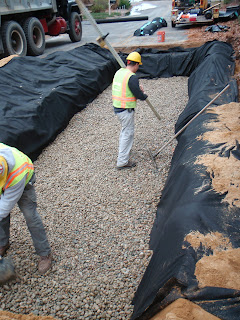 |
| Plastic treatment chambers in a modified stormwater system. |
By Lindsay Cook, Cape Cod Conservation District intern
Until the Fall of 2011, stormwater ran untreated into Popponesset Bay and Nantucket Sound. That’s when seven stormwater systems were installed underneath Mashpee Neck Road in the Mashpee. Stormwater is now filtered, removing contaminants before it enters the bay. These improvements will protect 102 acres of shellfish beds!
There are many factors to consider when installing a stormwater system. First is the amount of water to be treated. These systems are designed to handle the first inch of rainfall; researchers have found that 85 percent of all contaminants are absorbed and transported in the first inch of rain.
Second is the depth to the high water table. In order for stormwater systems to be safe for drinking water, the bottom of the system must be located at least two feet above the high water table. At the Mashpee Neck Road site, the first two sites easily cleared this threshold, but sites three through seven did not. Therefore, the first two sites received a conventional system and the others received a modified system that took up less vertical space than a standard system.
The conventional systems use leaching chambers and catch basins. When stormwater rushes down Mashpee Neck Road, it enters a catch basin through a manhole. A catch basin is a large concrete holding tank where water accumulates and particulate matter settles out. Particulate matter is anything from sand and leaves to gum wrappers and popsicle sticks.
After the particulates have settled to the bottom, the clearer water on top moves into a plastic pipe which leads to a leaching chamber. The leaching chamber has many small holes in the sides that let water out slowly. As the water fills up from the bottom, it trickles out the holes into an area of sand and rock where contaminants are filtered out.
The modified systems use small plastic treatment chambers instead of the larger leaching chambers of the conventional system. Because of their smaller size, the chambers must be placed side by side over a much greater area to absorb the same level of stormwater runoff than a conventional system could. More than 1,000 of these treatment chambers were installed underneath the road!
 |
| Laying down washed gravel for contaminant filtration. |
The modified systems use small plastic treatment chambers instead of the larger leaching chambers of the conventional system. Because of their smaller size, the chambers must be placed side by side over a much greater area to absorb the same level of stormwater runoff than a conventional system could. More than 1,000 of these treatment chambers were installed underneath the road!
In April more work will be done at this site. Stay tuned for details about the artificial wetland that will be built in the final phase of this project.
Some really helpful tips on installing and maintaining rain gardens can be found from the leading manufacturer of specialised grass protection & gravel reinforcement grid systems in the UK
ReplyDeleteThis is a particularly specialist area and you need the correct equipment to perform Groundwater Testing. This company provide the type of thing you are looking for.
ReplyDeleteA project like this will succeed if you consider the things mentioned above and be positive with the chambers that you’ll be applying. Getting the best chambers from reputable suppliers is also a vital thing you need to consider when installing a storm water system. The suppliers must usually have some expertise in land development, biology, and ecology because knowledge on these aspects is needed in producing the best storm water chambers.
ReplyDeleteSharon Strock
I have to agree with Sharon. Who your equipment manufacturer is is actually one of the essential factors that defines the strength and stability of your water chambers. Experience always matters, as it shows and proves the professionalism of your supplier.
ReplyDelete- Tabatha Tidd
No matter what system you choose to install, you would need to call the gas and electric company to make sure you know the location of all the pre-existing underground pipes. Perforated pipes between 4 inches and 12 inches in diameter are generally adequate for residential projects. You may bury them up to 4 feet.
ReplyDeleteMonica Barnes
Thank you for sharing with us,I too always learn something new from your post.
ReplyDeletewebpage link